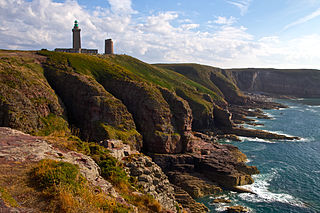
Brittany is the westernmost region of Metropolitan France. It covers about four fifths of the territory of the historic province of Brittany. It is one of two regions in Metropolitan France that do not contain any landlocked departments, the other being Corsica.

The history of Brittany may refer to the entire history of the Armorican peninsula or only to the creation and development of a specifically Brythonic culture and state in the Early Middle Ages and the subsequent history of that state.

Morlaix is a commune in the Finistère department of Brittany in northwestern France. It is a sub-prefecture of the department.

Charles Armand Tuffin, marquis de la Rouërie was a French military officer and nobleman who served during the American Revolutionary War. He was promoted to brigadier general after the Siege of Yorktown, and was a founder and early leader of the Chouannerie during the French Revolution. La Rouërie is less-remembered than Gilbert du Motier, Marquis de Lafayette and other Frenchmen in writings on France in the American Revolutionary War.
Bernard Le Nail was a French writer and Breton militant. After studying commerce at HEC Paris, he headed the promotional office of the Chamber of Commerce and Industry in Nantes. In 1979 he became Secretary General of the Comité d'Etude et de Liaison des Intérêts Bretons (CELIB) at Lanester. Between 1983 and 2000 he was director of the Cultural Institute of Brittany and had an important role in the conception and publication of the collection Les Bretons au-delà des mers : Explorateurs et grands voyageurs. He was also involved in the conception and publication of the following works: 500 Bretons à connaître, revising the Guide Bleu Bretagne, Guides Gallimard Bretagne, Les noms qui ont fait l’histoire de Bretagne, Dictionnaire des femmes en Bretagne, La Bretagne entre Armor et Argoat.
The Brittany national football team is the representative football team of Brittany, France. It is administered by the Breton Football Association (BFA). Brittany is neither affiliated to FIFA nor UEFA but is characterised as one of the six Celtic nations. Its games are held under the auspices of the French Football Federation and FIFA Regulations Amateur football in Brittany is administered by both the Ligue de Bretagne and the Ligue des Pays de Loire, which are regional associations within the French FA.

Jean Boucher was a French sculptor based in Brittany. He is best known for his public memorial sculptures which communicated his liberal politics and patriotic dedication to France and Brittany.

The Breton Regionalist Union was a Breton cultural and political organisation created August 16, 1898. It was a broadly conservative grouping dedicated to preserving Breton cultural identity and regional independence. It expressed the ideology of mainly middle-class and aristocratic groups to secure continuity in local administration and Breton culture.

Pierre-Paul Guieysse, was a French Socialist politician. He was Minister of the Colonies in the French Cabinet headed by Léon Bourgeois between 1895 and 1896.

Armand Dayot,, was a French art critic, art historian and leftist politician. He was born in Paimpol, Côtes-d'Armor, Brittany. He founded the journal L'Art et les artistes and the Breton liberal organisation les Bleus de Bretagne.

Charles Le Goffic was a Breton poet, novelist and historian whose influence was especially strong in his native Brittany. He was a member of the Académie française.
Françoise Morvan is a French writer who specialises in Breton history and culture.

The Revolt of the papier timbré was an anti-fiscal revolt in the west of Ancien Régime France, during the reign of Louis XIV from April to September 1675. It was fiercest in Lower Brittany, where it took on an anti-lordly tone and became known as the revolt of the Bonnets rouges or revolt of the Torrebens. It was unleashed by an increase in taxes, including the papier timbré, needed to authenticate official documents.
The Derby de la Bretagne, also known as the Derby Breton, is a football match in France. The match can potentially designate any match two clubs based in the historic province of Brittany; however, most of the time, it is employed by each club's supporters to mention the rivalry between major clubs Stade Rennais and FC Nantes, even if this particular fixture is often referred to as the West Derby.

Cornelius Ary Renan (1857–1900) was a French Symbolist painter and anti-clerical social activist.

Anders Osterlind was a French painter. He was the son of the painter Allan Österlind, and the father of watercolorist Nanic Osterlind.

France Bleu Breizh Izel - also known as France Bleu Lower Brittany, is a public service generalist radio station located in Lower Brittany, where Breton is traditionally spoken. The broadcast network and by extension Lower Brittany is made up of Finistère, western Côtes-d'Armor and western Morbihan. It was established on 3 August 1982 under the name Radio Bretagne Ouest.

Saint Herbot, also called Saint Herblon and Saint Hermelan, is one of the semi-legendary Breton saints, not officially recognized by the Catholic Church. His cult was very popular among Breton peasants, who saw in him a protector of horses and horned animals. There is a life of him in Latin, the Vita Herbaudi.














